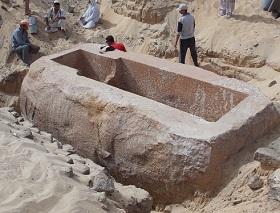Using AI to control energy for indoor agriculture
30 September 2024
Published online 1 February 2014

The tomb of Woseribre Senebkay, a pharaoh previously unknown to historians, has been unearthed in southern Egypt, promising insights into a period about which very little is known.
The remains of the mysterious king date back to the Second Intermediate Period (1650-1539 BC) and were uncovered in the ancient site of Abydos, 480 km south of modern-day Cairo. Except for some plundering of the tomb, the king's resting place had remained largely untouched for more than 3,600 years.
The archaeologists from the University of Pennsylvania, working with Egypt's antiquities ministry, reconstructed most of Senebkay's skeleton, apart from his missing jawbone. They say that Senebkay's tomb can provide information about a period in ancient Egypt from which few artefacts and records remain.
"It's exciting to come upon a king who is entirely unknown in the historical record up to this point," says Josef Wegner, the Egyptian Section Associate Curator of the Penn Museum, who led the excavation team.
During excavations last year, Wegner's team uncovered a 60-tonne, red quartzite royal burial chamber at the site, later identified to belong to Sobekhotep I, who was most likely the first pharaoh of the 13th Dynasty (1755-1630 BC).
Senebkay's tomb, discovered earlier this month, consists of four chambers and a decorated limestone burial chamber. The king had reused parts of Sobekhotep's burial chamber, including cedar from the coffin to make a canopic chest.
"Undoubtedly there is a royal necropolis that was established there and continued in use by successive kings in the dynasty," Wegner said. "Future work will tell us more about these characters."
Abydos is one of the most important archaeological sites in the country, containing artefacts and temples dating to every period of ancient Egypt, including a royal necropolis.
Intermediate periods in ancient Egypt were tumultuous times, occurring between dynasties with a dearth of national unity and a central administration. The Second Intermediate Period, to which Senebkay's tomb has been dated, is known for the arrival of the Hyksos from the Levant, who ruled the northern parts of Egypt, while local rulers reigned in the south.
Wegner believes that the discovery of Senebkay could mean that the Second Intermediate Period was actually a dynasty, and the kings may have ruled from Abydos.
When he first entered Senebkay's tomb, Wegner discovered it had been ransacked by ancient thieves. The king's mummified casing had been opened, and some of the tomb's contents removed. What remained identifies him as the "king of Upper and Lower Egypt" – suggesting he was viewed as the ruler of Egypt.
"We have…the makings of a lost dynasty and Senebkay was likely the first or second member of that dynasty," Wegner says. "The whole dynasty is buried in and around the same area where we found Senebkay's tomb.
"It's emerging as something like a Valley of the Kings," he added, referring to the famous site in Luxor, where Tutankhamun was entombed.
doi:10.1038/nmiddleeast.2014.32
Stay connected: